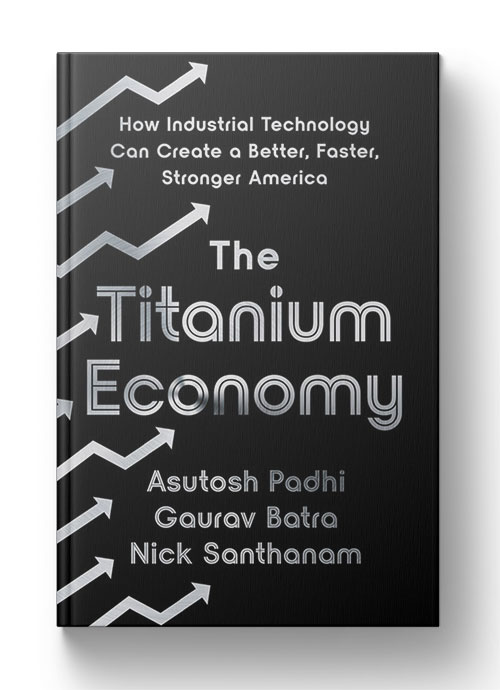Business and political leaders from around the world have gathered in Davos for the World Economic Forum’s Annual Meeting this week. Asutosh Padhi, McKinsey’s North America managing partner, is on site to share insights on an economic solution for inclusive growth hiding in plain sight: manufacturing.
The very word might inspire visions of a fading era that has given way to technology as the harbinger of economic growth. But according to Asutosh, the manufacturing industry is on the bleeding edge of technological innovation. Across the US, he says, it offers well-paying careers and the potential for social and economic upward mobility.
Asutosh is a co-author of the upcoming book The Titanium Economy: How Industrial Technology Can Create a Better, Faster, Stronger America. We caught up with him to learn about the economic promise of this sector.
Many people might be surprised by your assertion that manufacturing is the future of the economy in the US. What is “The Titanium Economy”?

Apple, Google, Amazon, and the like have become synonymous with innovation and symbols of future economic growth. There’s good reason for this: they are among the best-performing stocks of the last decade. But because of their cultural dominance, these digital technology titans can overshadow an impressive set of industrial technology companies that have performed just as well.
These companies comprise what we call “The Titanium Economy.” Generally speaking, they produce products that our economy runs on—but consumers don’t necessarily buy: aerospace parts, color enamels, recycled-plastic lumber, and more. They’re further characterized by lean operations, competitive salaries and benefits, inclusive workplace cultures, and a commitment to intelligent innovation. This economy is geographically diverse and product diverse.
What’s the biggest misperception about manufacturing you’ve heard at Davos this week?
Despite headlines of robots taking jobs and displacing manufacturing, the opposite is true. Making and moving things are still both the fundamental building block for equitable wealth creation and social improvements—but the digital revolution changed the skills needed for careers in this field. In addition, the average lifespan of an industrial company is 28 years, far exceeding that of tech companies, which is six years.
It’s true that US manufacturing industries carry heavy scars from the loss of jobs in the 1980s, when plants went dark and entire communities emptied of young people. But today, many companies are bringing their workforces back to the US as they recognize the benefits of building domestically.
The industrial tech economy is rising and resilient, beating analyst expectations, and creating jobs with strong salaries and benefits. Nearly half of the companies I studied for my upcoming book outperformed the S&P index from 2015 to 2020.
What is the profile of a titanium company? What are the characteristics and values that define them?

There are a variety of attributes. Typically, shareholder value comes from operational performance and market share, not solely expansion. These companies create jobs in the US and pay better-than-average wages and benefits. Their boards are generally very engaged, implementing ahead-of-the-curve standards for self-analysis, governance, and oversight. They are often family-owned, but aggressively innovative and committed to ongoing community relationships and education.
You’ve talked before about the multiplier effects that a revitalized US manufacturing industry could have. Can you elaborate?
Titanium industrials are opening plants, creating jobs, offering training programs, and generating indirect economic and job effects. Economists calculate that every 100 durable manufacturing jobs results in 750 or more indirect jobs—one of the highest multiplier effects of any industry. Industrial tech companies that succeed are often regenerating a community, drawing crops of young professionals, new immigrant families, gig workers, and artists. They also benefit stakeholders across the product cycle, leading to broad social benefits that keep pace with the success of the business.
What challenges lie ahead for titanium industrials?
If the last two years of empty grocery shelves and delayed deliveries taught us anything, it’s that we need to invest in stronger supply chains. Over decades we have been building supply chains that rely on lean warehouses and just-in-time systems that depend on predictability. These have left companies vulnerable to the risks associated with single suppliers or countries of supply, as well as newer threats like natural disasters and cyber-attacks.
To run a healthy, well-functioning supply chain, we must invest in workforce training programs, such as community colleges, technical training programs, and high school courses like wood shop and metal shop.
There’s also a stigma associated with manufacturing. Parents and society writ large often have a huge misperception as to the benefits of industrial jobs, which offer stable employment, highly livable wages, and a career path; yet many grads don’t consider a factory job.
Beyond economic benefit, what else do titanium industrials promise?
Many of these companies are emphasizing environmental responsibility and sustainability, and not just because decreasing environmental impact is a boon with investors and regulators. These companies are forward-thinking innovators. It’s the environment, bolstering food security, making clean energy safer and cheaper, keeping our air and water safe, and fostering and investing in entrepreneurship for the many, and more. Their potential is limitless.